Economic growth
What is economic growth?
Economic growth is the increase in the amount of the goods and services produced by an economy over time
Causes of economic growth
The following factors can help to achieve economic growth
Capital accumulation
Investment in capital equipment that is used by people at work is the key to economic growth. These resources will enable the workforce to produce consumer goods more efficiently.
Technological Progress
Improvement in technology will lead to more goods being produced from available resources. The country will have achieved a higher gross domestic product.
Improvement in quality of human resources
Improving the quality of existing workforce can lead to increased productivity and hence optimum utilisation of resources. The quality of human resource can be improved with education, training and healthcare.
Research and development
Discovering new sources of natural resources will add to the total output of the country.
Illustrating Economic growth using a PPC diagram
In case when the economy is operating with a deflationary gap. This means that the economy’s resources are not being fully utilised.

Point ‘a’ indicates a point where the economy is operating inside the PPC. With the economy achieving economic growth it would be equivalent to the movement from ‘a’ to ‘b’.
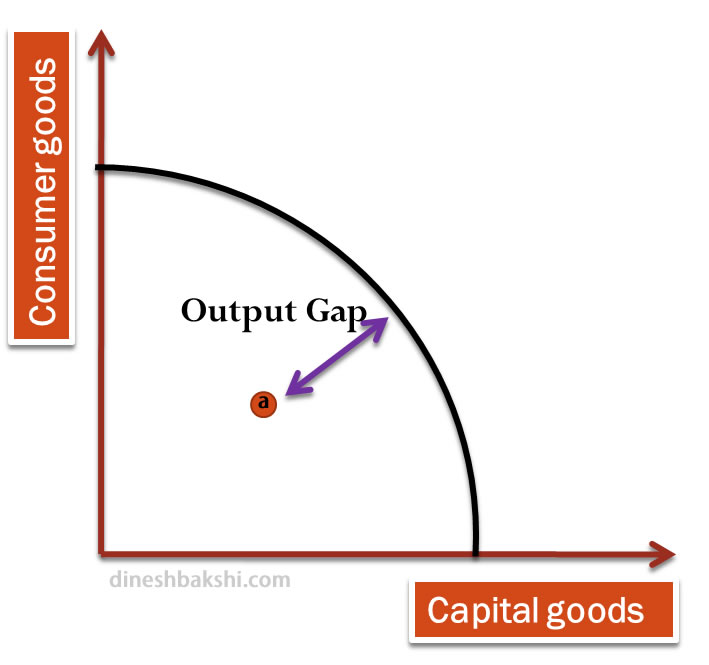
Economic growth can also be achieved by increasing the potential output. This is achieved through supply side policies.
As illustrated by the diagram the outward shift in the PPC signifies the increase in full employment level of output.
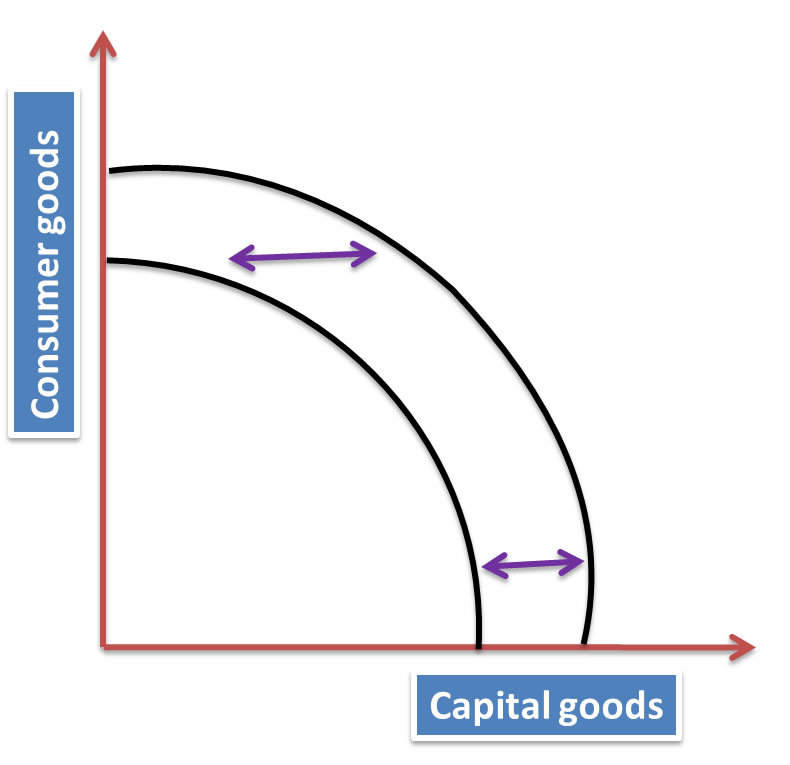
Illustrating Economic Growth using a AS/AD diagram
An economy operating below full employment level of output can be illustrated by the diagram. Where the gap between Y1 and Yf signifies deflationary gap.
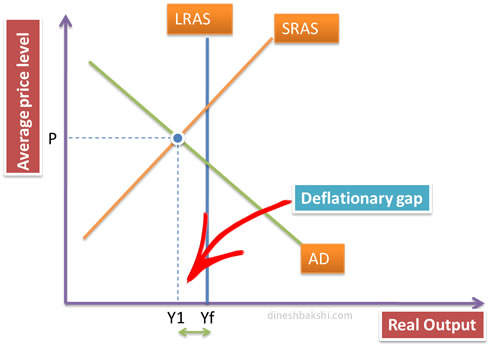

The movement of AD to the right (or increase in Aggregate Demand) will result in filling up of the deflationary gap and the economy will achieve full employment level of output. This is known as economic growth.
Economy can also achieve economic growth in the long term by increasing the potential output by increasing the efficiency of its factors of production. This can be illustrated by the movement of LRAS to the right. i.e. LRAS1 to LRAS2. This is achieved by government’s supply side policies.
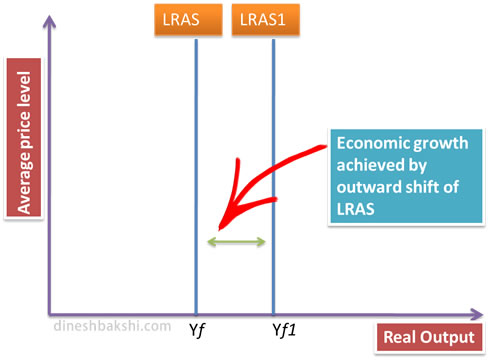
Consequences of economic growth
Positive
- Broadly speaking economic growth will result in the increase in living standard of the population.
- Increase in GDP (more precisely, GDP per capita) will result in the increase in the standard of living of its population.
- Greater income results in higher tax revenue for the government which can be spend of merit and public goods, again a higher living standard.
- An important factor which leads to economic growth is technology. Improved technology results in making our lives easy and comfortable.
- Economic growth leads to higher level of education and health service. This will result in a better social structure with a more stable political setup.
Negative
- Economic growth may not necessarily reflect the quality of life of the population. People may have more material gains at the cost of sacrificing leisure time and neglect of personal relationships.
- Economic growth leads to structural change in the economy, which might result in structural unemployment and income inequalities
- Environment may suffer due to high level of economic activities. High emissions of greenhouse gases are usually associated with economies achieving rapid economic growth.
Calculation of Rate of Growth [HL]

GDP and GNP
Gross Domestic Product (GDP) is the value of final goods and services produced within a country in a given period. It is the total of all activities in a country, regardless of who owns the productive asset.
Unlike Gross Domestic Product (GDP), which defines production based on the geographical location of production, GNP allocates production based on ownership. It is the total income that is earned by a country's factors of production regardless of where the assets are located.Gross National Product (GNP/GNI) is the market value of all products and services produced in one year by labour and property supplied by the residents of a country.
Thus GNP=GDP + (incomes earned from assets abroad-Incomes paid to foreign assets operating domestically)
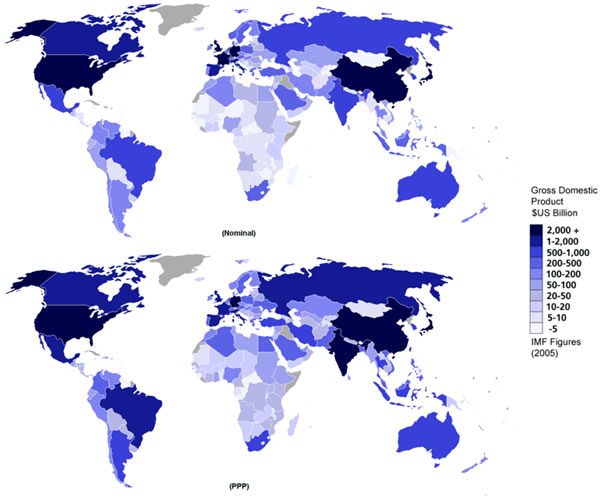
source: wikipedia
Nominal GDP & Real GDP
The raw GDP figures are called the Nominal or Current GDP. When comparing GDP figures from one year to another, it is desirable to compensate for changes in the value of money – i.e., for the effects of inflation or deflation. The GDP adjusted for changes in money-value in this way is called the Real GDP.
For example, suppose a country's GDP in 2000 was $100 million and its GDP in 2010 was $300 million; but suppose that inflation had halved the value of its currency over that period. To meaningfully compare its 2010 GDP to its 2000 GDP we could multiply the 2010 GDP by one-half, to make it relative to 2000 as a base year.
The result would be that the 2010 GDP equals $300 million × one-half = $150 million, in 2000 monetary terms. We would see that the country's GDP had, realistically, increased 50 percent over that period, not 200 percent, as it might appear from the raw GDP data.
GDP Deflator
|
GDP Deflator= |
Nominal GDP |
X 100 |
|
Real GDP |
GDP per capita
GDP per capita is the value of all final goods and services produced within a country in a given year divided by the average population for the same year.
Comparisons of national wealth are also frequently made on the basis of nominal GDP, which does not reflect differences in the cost of living in different countries. However, GDP per capita is often considered an indicator of a country's standard of living and often used as an economic development indicator.
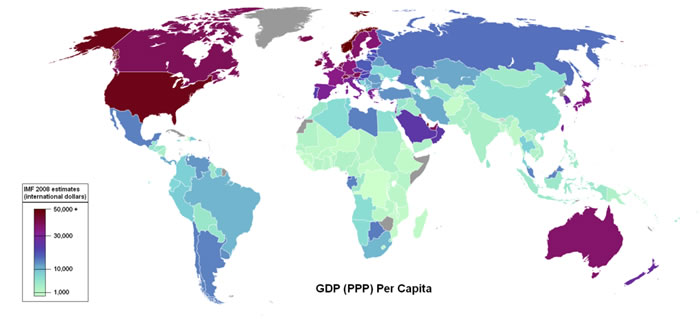
source: wikipedia
Watch a Video-GDP
Watch a Video - Real GDP
Output methods
It is the Market value of all final goods and services calculated during 1 year. In other words, add up the value of all goods and services produced in the country.
There are three stages in calculating it.
Firstly, the Gross Value of domestic output in various economic activities is estimated
Secondly, the value of intermediate consumption, i.e., the cost of material, supplies and services used to produce final goods or services is determined.
Finally, intermediate consumption figures are deducted from Gross Value to obtain the Net Value of Domestic Output.
Income method
In this methods GDP is derived by adding up all income i.e. wages and salaries, profits, rent and interest.
Expenditure method
All expenditure incurred by individual during 1 year.
GDP (Y) is a sum of Consumption (C), Investment (I), Government Spending (G) and Net Exports (X – M).
Y = C + I + G + (X ? M)
To derive GDP using the expenditure approach, we must look at each of the separate components of expenditures and then add them together. These components are consumption expenditures, investment, government expenditures, and net exports.
Consumption is spending by households on goods and services. Goods include household spending on durable goods, such as automobiles and appliances, and non durable goods, such as food and clothing. Services include such intangible items as haircuts and medical care.
Investment is the purchase of goods that will be used in the future to produce more goods and services. It is the sum of purchases of capital equipment, inventories and structures.
Government Purchases include spending on goods and services by local, state and central governments. It includes the salaries of government workers as well as expenditures on public works.
Net Exports equal the foreign purchase of domestically produced goods(exports) minus the domestic purchases of foreign goods (imports). The net in net exports refers to the facts that imports are subtracted from exports.





